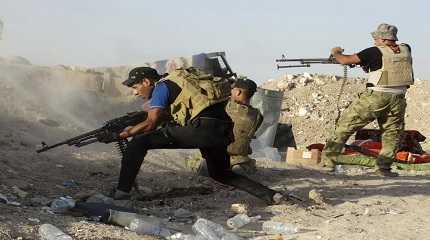
BEIRUT (AP) — The Islamic State group has carried out its deadliest attacks in more than a year, killing dozens of civilians and security officers in the deserts of central Syria, even as people of northern Syria have been digging out of the wreckage from the region’s devastating earthquake.
The bloodshed was a reminder of the persistent threat from IS, whose sleeper cells still terrorize populations nearly four years after the group was defeated in Syria.
The attacks also underscored the extremists’ limitations. IS militants have found refuge in the remote deserts of Syria’s interior and along the Iraqi-Syrian border. From there, they lash out against civilians and security forces in both countries. But they are also hemmed in by opponents on all sides: Syrian government troops as well as Kurdish-led fighters who control eastern Syria and are backed by U.S. forces. American raids with their Kurdish-led allies have repeatedly killed or caught IS leaders and, earlier this month, killed two senior IS figures.
The IS attacks this month were largely against a very vulnerable target: Syrians hunting truffles in the desert.
The truffles are a seasonal delicacy that can be sold for a high price. Since the truffle hunters work in large groups in remote areas, IS militants in previous years have repeatedly preyed on them, emerging from the desert to abduct them, kill some and ransom others for money.
On Feb. 11, IS fighters kidnapped about 75 truffle hunters outside the town of Palmyra. At least 16 were killed, including a woman and security officers, 25 were released and the rest remain missing.
Six days later, on Friday, they attacked a group of truffle hunters outside the desert town of Sukhna, just up the highway from Palmyra, and fought with troops at a security checkpoint close by. At least 61 civilians and seven soldiers were killed. Many of the truffle hunters in the group work for three local businessmen close to the Syrian military and pro-government militias, which may have prompted IS to target them, according to the Britain-based Syrian Observatory for Human Rights, an opposition war monitor, and the Palmyra News Network, an activist collective that covers developments in the desert areas.
Smaller attacks around the area killed 12 other people, including soldiers, pro-government fighters and civilians.
The area is far from the northern regions devastated by the Feb. 6 earthquake that killed more than 46,000 people in Turkey and Syria. Still, IS fighters “took advantage of the earthquake to send a message that the organization is still present,” said Rami Abdurrahman, who heads the Observatory.
Friday’s attack in Sukhna was the group’s deadliest since January 2022, when IS gunmen stormed a prison in the northeastern city of Hassakeh that held some 3,000 militants and juveniles. Ten days of battles between the militants and U.S.-backed fighters left nearly 500 dead.
The prison attack raised fears IS was staging a comeback. But it was followed by a series of blows against the group, which reverted to its drumbeat of smaller-scale shootings and bombings.
It’s too early to say if the new spate of attacks marks a new resurgence, said Aaron Y. Zelin, a senior fellow at the Washington Institute for Near East Policy.
“It’s the biggest attack in a while. So the question is if it’s just a one-off attack or if they are reactivating capabilities,” said Zelin, who closely follows militant Islamic groups and founded Jihadology.net.
He said IS fighters have been less active every year since 2019 and noted that the recent attacks hit civilians, not tougher security targets.
In 2014, IS overran large swaths of Syria and Iraq and declared the entire territory a “caliphate,” where it imposed a radically brutal rule. The U.S. and its allies in Syria and Iraq, as well as Syria’s Russian-backed government troops, fought against it for years, eventually rolling it back but also leaving tens of thousands dead and cities in ruins. The group was declared defeated in Iraq in 2017, then in Syria two years later.




